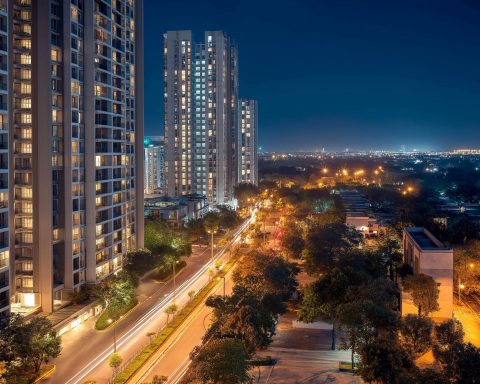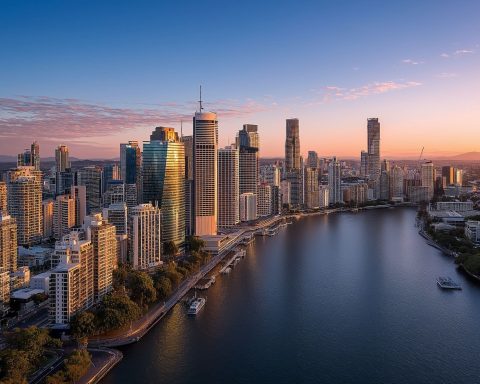Dublin’s property market is experiencing a dramatic surge in 2025, marked by soaring prices and a severe housing shortage that has buyers scrambling. Residential home values are climbing at their fastest pace in years amid fierce competition and record-low supply of homes for sale. At the same time, rents in the capital have hit all-time highs due to a decade-long rental housing crunch globalpropertyguide.com globalpropertyguide.com. On the commercial side, Dublin’s office and industrial sectors are rebounding from a pandemic-era slump, with investor sentiment and demand picking up sharply into 2025. This report provides a comprehensive analysis of Dublin’s residential and commercial real estate in 2025, current market performance, and forecasts for the next few years. We also highlight investment opportunities – from high-growth neighborhoods to in-demand property types – and examine how government policies, economic conditions, and new housing regulations are shaping the market. Finally, we offer targeted insights for investors, homebuyers, and real estate professionals navigating Dublin’s dynamic property landscape.
Residential Real Estate in 2025: A Market on Fire
Home Price Boom Amid Chronic Supply Shortage: Dublin’s housing market has been exceptionally heated in 2025. The average Dublin home price reached about €460,700 by mid-2025, a 12.2% jump year-on-year, the steepest annual rise in eight years. Official data show Dublin residential prices up 6–7.5% year-on-year in early 2025 cso.ie cso.ie, but industry reports indicate even larger gains for listed homes as bidding wars drive sale prices well above asking. The median Dublin dwelling price stands around €360,000, up ~7.5% from last year, though many areas are far higher. In upscale South Dublin locales (e.g. Blackrock, D4, D6), median prices range from €665,000 to €750,000+, whereas more affordable suburbs like Swords or Tallaght average around €400,000–€415,000. Demand is fueled by a robust economy and demographics – steady population growth, rising employment and wages, and households eager to buy as buying is often cheaper than long-term renting under current conditions investropa.com. First-time buyers remain very active (especially for homes under €500k), often encountering intense competition with multiple offers on scarce listings.
Record-Low Inventory and Construction Challenges: The supply of homes for sale in Dublin is critically low, which is intensifying the price boom. Fewer than 3,500 properties are listed for sale across the entire Dublin region – a figure 17% lower than a year ago and extremely small for a city of its size. Would-be sellers are hesitant to list for fear of not finding a replacement home, creating a self-perpetuating inventory crunch globalpropertyguide.com. New construction has not kept pace with demand, despite government initiatives. Ireland’s Housing for All plan (launched 2021) targets 300,000 new homes by 2030, but delivery is still falling short of needs. Nationwide housing completions actually dipped ~6.7% in 2024 to about 30,330 units, and Dublin in particular faces delays in apartment projects. In fact, 2025 apartment completions in Dublin are projected to fall sharply – by around 40% below 2023 levels (and ~18% below 2024) – due to high construction costs, financing hurdles, and planning bottlenecks. This pullback in new supply is exacerbating Dublin’s mismatch between housing demand and availability.
On a positive note, a record number of housing starts were initiated in 2024 (over 60,000 units started, +84% YoY nationwide) globalpropertyguide.com, which offers hope that completions will ramp up in the coming years. Industry forecasts (EY-Euroconstruct) are optimistic, projecting housing completions to rise to 38,000 in 2025, 40,000 in 2026, and 42,000 in 2027 across Ireland. If realized, that level of output would finally approach the ~40,000+ units per year many experts say Ireland needs to meet demand. In the interim, however, Dublin’s “unrelenting supply constraints” are expected to cause further price increases through 2025, keeping the market tilted firmly in sellers’ favor.
Rental Market Pressure and Regulations: Dublin’s rental sector remains under acute stress, with inadequate supply driving rents to new heights. Rents have surged ~117% over the past decade (2015–2025) in Ireland globalpropertyguide.com. While rent inflation has cooled from the 15% annual spike seen in late 2022, it still stood at 7.7% year-over-year as of January 2025 globalpropertyguide.com. Dublin city rents are the highest in the country – by Q4 2024, average asking rent in Dublin City Centre exceeded €2,400 per month. Even small units are pricey: a Dublin one-bedroom now averages roughly €1,800/month in rent (+7.7% YoY). Vacancy rates are effectively zero; the rental vacancy in Dublin is about 1% – a record low indicating virtually no available homes to rent.
The government’s Rent Pressure Zone (RPZ) legislation – which capped rent increases (often ~2–4% annually in designated high-pressure areas) – has been in place for several years to temper rent hikes. However, this RPZ framework is set to expire in December 2025, and its future is uncertain. The current rent caps have discouraged some investment in rental supply, contributing to a slowdown in new “build-to-rent” apartment development. Policymakers are expected to revisit rent regulations in late 2025, weighing the need to protect tenants against the risk of further deterring landlords and developers. Meanwhile, the rental crisis shows little sign of ending soon. As one Dublin economist bluntly observed, “we are over a decade into a rental crisis and have very little to suggest that it will end any time soon” – new rental construction surged in 2022–23 but has since fallen back, and virtually no new rental housing is being added outside Dublin. With demand still climbing and homeownership increasingly out of reach for many, upward pressure on rents will likely persist in the near term.
Affordability and Mortgage Trends: Soaring prices and rents have worsened affordability, especially for first-time buyers. Mortgage lending had been constrained by central bank rules and, more recently, higher interest rates. However, 2025 is bringing some relief on the financing front. The European Central Bank, after aggressive rate hikes in 2022–23, shifted to a more accommodative stance – cutting key rates by 0.25% in December 2024 and again in January 2025. Irish mortgage rates have begun to edge down from their peak, reaching a 20-month low by early 2025. The average new mortgage rate is now around 3.7% (down from ~4.2% a year prior), and further modest ECB rate reductions are anticipated over the next year. Easing rates, combined with rising incomes, are incrementally improving homebuyer affordability globalpropertyguide.com globalpropertyguide.com. In fact, falling interest rates are “helping the affordability equation and supporting appetite” on the demand side globalpropertyguide.com, notes one Irish property agency executive. The Irish government has also extended buyer supports like the Help-to-Buy scheme (income tax rebate for first-time buyers) and introduced a First Home shared-equity scheme to help bridge deposit gaps – policies that boost purchasing power for young buyers. Even so, with Dublin prices at record highs, saving a sufficient deposit remains a challenge. Affordability will remain stretched until supply improves or price inflation abates. As discussed below, many experts predict price growth will moderate in the coming years, which could allow household incomes to catch up a bit.
Commercial Real Estate in 2025: Rebounding with Caution
Dublin’s commercial property sectors – which include offices, retail, industrial/logistics, and others – are showing strong signs of recovery in 2025 after a turbulent 2023. Last year saw significant headwinds: rising interest rates, yield expansion, and global tech sector layoffs led to a valuation correction (commercial values fell sharply in 2023). Now, with Ireland’s economy proving resilient and credit conditions improving, investor sentiment and occupier demand have bounced back markedly.
Office Market – Flight to Quality: The Dublin office sector is regaining momentum in 2025, but it’s a tale of two markets. Demand is largely concentrated on high-quality, modern office spaces (especially those with strong sustainability credentials), while older, non-efficient buildings face obsolescence or need repurposing. After the pandemic-driven shift to remote/hybrid work, many companies downsized or delayed office decisions. By late 2024, however, office take-up saw a rebound – occupier demand in Q4 2024 was up +15% compared to the year before, as firms began executing on delayed real estate needs. Dublin’s continued strength in tech, finance, and professional services is sustaining a baseline level of office demand, particularly for prime offices in the city center and Silicon Docks. The availability of top “green” office space is shrinking in central Dublin, which is pushing rents higher for LEED-certified and energy-efficient buildings. Older offices with lower environmental standards, by contrast, are seeing value-add investors consider refurbishment or conversion strategies. Many such properties may need retrofitting to stay competitive, a trend 71% of surveyors expect to accelerate (especially retrofits for sustainability). Overall, Dublin office rents have stabilized and prime rents could begin rising again by late 2025 as supply of Grade A space tightens. The office vacancy rate (particularly for secondary stock) remains elevated, but the “bifurcation” in the market means prime occupancy is high while lesser buildings struggle. Investors are increasingly selective, focusing on well-leased, environmentally compliant assets. Notably, some large transactions demonstrated renewed confidence – for example, the sale of One & Two North Dock in late 2024 showed institutional capital is active when pricing is attractive.
Retail & Hospitality – Resilient Consumer Demand: Dublin’s retail property segment has mounted an impressive recovery as foot traffic and spending rebounded strongly post-pandemic. By Q4 2024, retail occupier demand was +22% higher than a year earlier, and this momentum is carrying into 2025. Prime high streets like Grafton Street and Henry Street are seeing new international retailers and expanding domestic brands actively seeking space. Demand is particularly robust for well-located units in shopping streets, top shopping centres, and retail parks, driven by Ireland’s healthy consumer spending and the desire of retailers to establish flagship presences. Retail rents, which had dipped during 2020–21, are rising again in prime locations. The experiential retail trend is also evident – entertainment and leisure concepts are filling spaces to draw in customers. In 2024, two new “experiential” venues (Pitch and Supersocial) opened in Dublin, and more are slated for 2025 (e.g. boutique bowling, interactive darts bars, etc.). This diversification is boosting footfall and demand for large units that can accommodate unique leisure uses. Hospitality and hotels likewise remain strong: 2024 saw active investment in Dublin hotels, and 2025 is expected to bring continued high occupancy (barring any new travel shocks). A substantial pipeline of new hotel rooms is opening in Dublin in 2025, which may put some pressure on room rates, but overall the tourism and hospitality outlook is positive cbre.ie.
Industrial & Logistics – High Growth Sector: The industrial and logistics real estate sector is a star performer in Dublin’s commercial market. Even through economic fluctuations, demand for warehouses and distribution facilities has been robust, driven by e-commerce growth and Ireland’s expanding pharmaceutical and technology supply chains. 2024 had some slowdown due to global uncertainties, but heading into 2025 there are several large requirements for industrial space in Dublin that are expected to revive activity. Investor sentiment toward industrial assets turned positive for the first time in two years by late 2024. Prime industrial properties are predicted to lead in value growth, with capital values forecast to rise ~3.2% and prime industrial rents ~3.1% in 2025. (These may seem like modest gains, but after the sharp valuation correction in 2023, any positive growth signifies a market turning the corner.) Modern logistics facilities – especially those near Dublin Airport, the Port, and major motorways – are in very high demand. Vacancy in quality logistics parks is extremely low, and rents for prime industrial units are hitting record levels. One factor to watch is international trade policy; the prospect of new U.S. tariffs or global trade friction is a concern that could dampen demand for warehouse space. Nonetheless, with e-commerce and data center activity (Ireland is a major data center hub) continuing to expand, the industrial real estate outlook in Dublin remains broadly strong.
Commercial Investment and Values: After a quiet 2023, commercial property investment in Ireland is poised to rebound in 2025. Total investment volumes in 2024 were about 40% below the long-term average, but confidence is returning. The European Central Bank’s rate cuts and looser credit conditions have improved financing availability, and fewer properties are deemed “overpriced” now after the 2023 price correction. The Society of Chartered Surveyors Ireland expects a significant upswing: commercial capital values are projected to rise ~+15% in 2025, following the roughly -27% drop recorded in late 2023. Rental values across commercial sectors are likewise forecast to grow around +19% in 2025 (versus a -7% decline in late 2023). Much of this recovery will be led by prime segments – Grade A offices, modern logistics, and high street retail – which are already seeing yield compression as investors bid again. For example, yields on the best Dublin offices and industrial assets stabilized in early 2025 and could sharpen if competition increases. By contrast, secondary assets may lag until repositioned. Overall, Dublin’s commercial real estate is entering a growth phase in 2025, supported by rising occupier demand, easier credit, and Ireland’s strong economic fundamentals. That said, the market is more discerning than in past booms: sustainability and quality are paramount, and older properties will need upgrades (or conversions) to remain relevant in the coming years.
Market Outlook: Forecasts for the Next Few Years
Residential Market Projections: Looking beyond 2025, most analysts anticipate a moderation in Dublin’s house price inflation – but not an outright crash – as supply slowly improves. After back-to-back years of rapid gains (~8% in 2024 and a projected 7–10% in 2025), price growth is expected to decelerate to more sustainable levels by 2026-27. In fact, experts predict the current rapid growth will likely slow markedly or even plateau by late 2025 as new housing stock comes on stream and affordability limits are reached investropa.com investropa.com. Some forecasts even allow for a slight dip in Dublin prices in 2026 if construction significantly ramps up and interest rates remain steady investropa.com investropa.com. A recent mid-2025 analysis suggests Dublin prices may “plateau or dip” after the summer of 2025 investropa.com, given the pipeline of new homes and pushback on affordability. However, any price cooling is likely to be gradual. Demand fundamentals – robust population growth (buoyed by both natural increase and immigration), high employment, and cultural preference for homeownership – will persist into the next decade, supporting housing values. In short, a continued rise in supply should temper prices, but is unlikely to trigger a severe decline unless there’s an external economic shock.
On the supply side, the outlook is cautiously optimistic. As noted, housing completions are forecast to rise each year through 2027. If Ireland can sustain ~40k annual new units nationally (with a significant portion in Greater Dublin), by 2026-2027 the worst of the shortage could finally begin to ease. Government initiatives – from fast-tracking planning approvals to leveraging state lands for development – are expected to show more impact in coming years. One encouraging sign is the shift of construction capacity from commercial to residential projects, thanks in part to policy incentives. Industry voices emphasize that structural reforms (streamlining permitting, reducing construction costs, and incentivizing affordable housing) are still needed for a long-term fix. In the meantime, housing price growth is projected to calm to low-single-digit percentages annually by 2026, assuming interest rates continue to ease and around 35k+ units are delivered per year. Dublin’s price trajectory will depend on whether it can get a large share of those new builds; otherwise the city’s prices could continue outperforming the national average due to its chronic undersupply and outsized demand.
Rental market pressures are also expected to persist in the near term. As long as Dublin’s population and job growth outstrip the creation of new rental units, rents will likely keep rising (albeit at a slower pace if more supply comes in). Some relief for renters may come if the Rent Pressure Zone rules are replaced or extended after 2025, potentially with updated measures to protect tenants from extreme hikes. Additionally, if homebuying becomes more attainable (through lower interest rates and more new homes), rental demand growth could soften slightly as some households shift from renting to owning. Most forecasts see rents continuing to rise into 2026, but at a moderating rate – possibly in the low-to-mid single digits annually rather than the 7-10% seen recently. That outlook assumes policy efforts (like tax tweaks to retain small landlords and new large-scale rental blocks being completed) will gradually improve rental supply.
Commercial Market Outlook: Dublin’s commercial real estate is entering an expansion phase that should carry forward over the next few years, barring global shocks. Economic forecasts for Ireland are upbeat, with the European Commission projecting ~4% GDP growth in 2025 and continued low unemployment around 4.4-4.5%. This strong macro backdrop, combined with Ireland’s status as a tech/FDI hub, bodes well for property demand. In the office sector, 2025’s recovery in take-up is expected to continue into 2026 as companies finalize post-pandemic strategies. However, the flight-to-quality will persist: we anticipate prime office rents and values rising modestly (perhaps 2–5% per year) through 2027, while secondary offices may see flat or negative growth unless refurbished. By 2026-27, a wave of older office stock could be converted or upgraded, which may actually reduce overall office inventory but improve occupancy and rent metrics for the remaining competitive buildings.
Industrial and logistics properties should remain a top-performing asset class. With e-commerce, pharmaceuticals, and data center operations expanding, demand for warehouses around Dublin will stay high. New logistics developments (e.g. the second phase of Blarney Business Park and expansions at Little Island in Cork, which serves as a proxy for regional demand) are underway. Even by 2027, expect industrial vacancy in Dublin to be minimal and rents at peak levels, given limited industrial land and strong occupier needs. Some moderate growth in supply is coming (projects near the port and airport), but likely not enough to outpace demand. Thus, capital values for industrial assets have room to appreciate further in 2026-28, though at a slower pace than the initial 2025 rebound.
Retail and hospitality outlook is cautiously positive. Consumer spending in Ireland is projected to stay healthy, aided by real wage growth and budget surpluses that could lead to tax cuts or public spending. Retailers will continue expanding in Dublin’s prime areas – indeed, new entrants are expected on high streets through 2026, keeping vacancy low and supporting rent growth in prime retail by a few percent annually. The main risk to retail property is a downturn in consumer confidence or a shift to online spending, but physical retail in Dublin has shown resilience by focusing on experience and tourism. The hotel sector is adding substantial new room supply in 2025-26, which might cap room rate growth temporarily cbre.ie, yet Dublin’s tourism demand trend is upward, so hotel occupancy and investor interest should remain solid over the next few years.
Importantly, capital markets are improving and that trend should extend beyond 2025. With borrowing costs likely to fall further (ECB rates potentially coming down gradually through 2025-26), investors will find renewed capacity to finance deals. Many international investors paused in 2022-23 due to high financing costs; as that pressure alleviates, we anticipate more inbound capital targeting Irish real estate from 2025 onward. The rebound in values forecast for 2025 (capital values +15%) suggests a lot of the repricing has already occurred, so 2026-27 could see steadier growth in the low-to-mid single digits annually for commercial values broadly – essentially tracking income growth. One caveat: geopolitical or global economic risks (e.g. a significant EU or US recession) could dampen occupier demand and investment activity at any point. Dublin’s market is internationally influenced, so it’s not immune to external shocks. Nonetheless, at present the trajectory is one of recovery and expansion, making the next few years promising for well-positioned real estate assets.
Investment Opportunities and High-Growth Areas
Despite high prices, Dublin’s real estate market continues to offer compelling opportunities for savvy investors in 2025 and beyond. In fact, the current dynamics – low supply and high demand – are creating pockets of high growth that certain strategies can tap into:
- Residential Rental Investments: With rents near record highs and a persistent housing shortage, buy-to-let residential properties in Dublin remain attractive. Gross rental yields on Dublin apartments average around 6.5–7%, which, coupled with expected rent growth ~3–5% per year, can offer solid cash flow. Investors are especially focusing on build-to-rent (BTR) developments – larger scale apartment blocks designed for renting. Several institutional investors (including REITs and international funds) have shifted toward residential assets, viewing them as resilient given Ireland’s housing undersupply. High-growth neighborhoods for residential investment include areas with upcoming transport links or regeneration plans. For example, North Dublin suburbs (Fingal) have seen the fastest house price growth (~9.5% YoY) in the city janetcarroll.ie, yet still have relatively affordable entry prices, making them ripe for future gains as infrastructure (like the planned Metrolink rail to the Airport/Swords) improves. West Dublin locales (e.g. Lucan, Clondalkin) and parts of South City suburbs where new housing estates are being built also present opportunities – these areas may benefit from spillover demand as buyers get priced out of the city core.
- New Development and Land: The development land sector is poised for increased activity, aided by lower interest rates and strong end-user demand. Developers who can navigate planning and rising construction costs will find opportunities in delivering housing – both private and social – particularly medium-density schemes on Dublin’s fringes and brownfield sites within the city. Zoned land in Dublin with planning permission is extremely valuable now, as the bottleneck is often getting projects approved. Investors might target land in growth corridors (e.g. along the new Dart+ and Metrolink routes, or large tracts in Cherrywood, Clonburris, Adamstown which are designated new towns) – these are areas expected to see thousands of homes in coming years. Additionally, converting or repurposing existing properties is a growth niche: with many older offices potentially unlettable, there is opportunity to convert obsolete commercial buildings into residential units or student housing, capitalizing on the housing shortage. The government has signaled support for such conversions by streamlining change-of-use planning rules in some cases.
- Prime Commercial Assets at Value: The correction in 2023 means that many commercial properties in Dublin are trading at a discount to their pre-2022 values. This “reset” opens a window for investors to acquire high-quality assets at more reasonable pricing. Notably, prime offices with strong tenants can be bought at yields higher than in recent years; as the market recovers, these yields should compress, delivering capital appreciation. Similarly, shopping centres and retail parks that proved their resilience (with stable occupancy and sales) are now attractively priced relative to the income they produce. The case of Blanchardstown Centre – a major Dublin mall that sold in 2024 – illustrates that buyers are willing to step in when a prime asset is repriced to market. Investors with a medium-term view could target such distressed or repriced commercial assets now, to ride the value upswing forecast through 2025–2027.
- Industrial/Logistics Development: Given the strength of the logistics sector, there is high growth potential in developing new warehouse facilities. Locations near Dublin Airport, along the M1/M2 corridor, and the Naas Road (M7) logistics clusters are particularly in demand. If investors can secure land or older industrial sites for redevelopment, the yield on cost can be favorable, as prime industrial rents are still climbing and land supply is tight. Additionally, last-mile distribution centers in and around the city (serving online retail and grocery delivery) represent an emerging opportunity – older light-industrial buildings in suburban Dublin can sometimes be repositioned for this use.
- Specialized Sectors: Some niche sectors are also worth watching. Purpose-Built Student Accommodation (PBSA) is one: Dublin’s universities are expanding and student numbers are growing, yet the city has a chronic shortage of modern student housing. Projects in this category tend to fill up rapidly upon completion. Another niche is healthcare real estate – nursing homes, private hospitals, and medical centers. Ireland has an aging population and a need for new healthcare facilities; these are often backed by government payments (in the case of nursing homes) or long leases, making them stable investments. Indeed, healthcare was a defensive asset class that continued to attract international capital even through 2024.
In summary, investors who target the right segments – residential rentals, logistics, prime repositioned offices, and select development plays – can find substantial upside in Dublin’s market. The key is to align with Ireland’s structural needs (housing, modern logistics, etc.) and leverage the current timing (recovering market with improving finance). Of course, due diligence is critical: properties should be evaluated for regulatory compliance (e.g. energy ratings for buildings), and planning risk should be carefully managed in development deals.
Policy, Economy, and Regulatory Impact
Government Housing Policy: The Irish government’s actions (and inaction) heavily influence Dublin’s real estate trajectory. The flagship Housing for All policy has committed unprecedented funding to boost housing supply by 2030, including subsidies for affordable housing, grants to reactivate vacant homes, and reforms to accelerate planning decisions. These interventions are credited with helping 2024’s surge in housing starts and reallocating construction resources toward residential projects. In the short term, the government has also offered tax incentives for small landlords to stem their exodus (as many were selling off properties due to past rent caps and an eviction ban that was in place during COVID). A temporary eviction moratorium, enacted in late 2022 but since lifted, likely prevented some evictions but also prompted some landlords to leave the rental market once it ended, tightening supply further. Going forward, the coalition government (re-elected in late 2024) has indicated it will pursue centrist, pro-supply housing policies and maintain continuity in regulations. This continuity provides certainty for developers and investors. For example, the “First Home” shared equity scheme was extended and may be expanded to help more buyers trade up (which could free up starter homes). Also, the Help-to-Buy tax rebate for first-time buyers was renewed in Budget 2025. These demand-side supports keep the buyer pool robust, but the government is balancing them with supply-side measures to avoid simply inflating prices.
A crucial regulatory event on the horizon is the expiration of Rent Pressure Zones at end-2025. Policymakers are actively debating how to replace or reform Ireland’s system of rent control. One possibility is a nationwide rent register and stricter enforcement against illegal hikes; another is extending rent caps but with adjustments for inflation. The decision will affect landlord confidence and tenant stability alike. Clarity on this is expected by Q4 2025 – any major changes will reverberate through Dublin’s rental investment scene, either encouraging or discouraging future rental development.
Planning and Zoning Reforms: Ireland’s planning process has historically been slow and litigious, contributing to housing delays. The government is streamlining procedures, including limiting judicial reviews that can hold up big projects. Height and density rules have been relaxed in many parts of Dublin to allow taller apartment buildings and smaller unit sizes (like studios and co-living spaces) to increase urban supply. In late 2022, new guidelines removed minimum parking requirements for city developments to reduce costs and space wastage. The impact in 2025-2027 should be faster approvals for compliant projects and more innovation in housing types (micro-units, prefab construction, etc.). Additionally, a Vacant Homes Tax was introduced to prod owners of empty properties to sell or rent them out – over time this could inject a few hundred more units into Dublin’s market, though it’s not a game-changer. The government is also investing part of its large budget surplus (from corporate tax windfalls) into infrastructure that supports housing – for instance, funding for new transport links and utilities in growth areas, which in turn unlocks development land.
Economic Conditions: Ireland’s economic outlook remains a pillar of the real estate market. As of 2025, the domestic economy is growing steadily, with robust employment and rising real wages. Ireland also enjoys substantial government surpluses, giving it fiscal room to invest in housing and infrastructure. However, Ireland’s small, open economy is heavily influenced by global conditions. One risk is its reliance on multinational corporations (especially US tech and pharma) – any downturn or policy change (e.g. higher global corporate tax regimes, or US protectionist measures) could impact jobs and office demand. Notably, Ireland has re-elected a centrist, pro-business government which should reassure foreign investors and maintain a stable policy environment for real estate. On the monetary side, as discussed, the interest rate cycle has likely peaked; the expectation of gently lower interest rates over the next 12–24 months will support real estate activity by easing financing costs. Inflation in construction materials, which spiked in 2022, has moderated but remains a concern – high building costs still challenge viability for some projects, and government schemes to reduce costs (bulk purchasing materials, etc.) are being considered.
In summary, the policy and economic climate in 2025 is generally supportive of Dublin real estate: the government is prioritizing housing, the economy is strong, and regulation is trending toward encouraging development (though the exact path of rent control is a wildcard). Stakeholders should stay tuned to late-2025 policy announcements on rent caps and any new housing targets set by the coalition. Real estate professionals widely view the stable political outcome of 2024’s election as a positive – it provides “certainty and continuity around regulation and policy” for the next five-year term, during which the hope is that Ireland can finally make a dent in its housing shortage and modernize its planning regime.
Insights for Different Audiences
For Property Investors
Opportunities: Investors in Dublin real estate can capitalize on the market’s strong fundamentals but should target segments with the best risk-adjusted returns. Residential rentals are a compelling play – Dublin’s severe housing shortage and high rents mean well-located rental properties can provide steady income and appreciation. Small apartments in central areas or family homes in commuter belts can yield ~6-7% and see ongoing rent uplifts. Additionally, with commercial values rebounding from their 2023 lows (projected +15% in 2025), now is an opportune time to acquire quality office or industrial assets at improved yields before the market fully prices in the recovery. Prime offices with strong ESG credentials and logistics facilities are likely to outperform in the next upswing.
High-Growth Areas: Investors should watch Dublin’s emerging hotspots. In residential, areas like Fingal (North Dublin) have both high growth rates and significant development plans – a combination that promises future value as infrastructure and supply catch up janetcarroll.ie. Regeneration zones (e.g. the Dublin Docklands’ expansion, or large master-planned communities in West Dublin) offer chances to get in early in transforming neighborhoods. For commercial, Dublin’s city center remains the focal point for office demand, but suburban office parks (with lower rents and parking, appealing in a hybrid work era) may see increased interest from occupiers seeking cost savings. The industrial clusters around the M50 orbital motorway and near Dublin Port/Airport are effectively “growth corridors” where any investment in warehouse/logistics space is likely to see strong tenant demand.
Risk Factors: Investors should also heed potential risks. Interest rate changes can affect property yields – while rates are easing now, any inflation resurgence could alter that outlook. Political/regulatory changes such as a dramatic rent control extension or higher property taxes on investors could impact returns (though no such moves are firmly on the horizon, given the centrist government stance). It’s also wise to prepare for liquidity considerations: Irish property is relatively illiquid, and while 2025 looks active, one should have a medium-to-long-term horizon, especially in development projects that can be delayed by planning or construction bottlenecks.
For Homebuyers
Navigating a Seller’s Market: For individuals and families looking to buy a home in Dublin, 2025’s market is challenging but not without hope. Buyers need to be well-prepared and decisive. With listings at record lows and average selling times near historic lows globalpropertyguide.com, desirable properties often get snatched up within weeks (or even days). It’s crucial to have mortgage pre-approval in hand and be ready to bid quickly – sometimes above the asking price – to beat the competition. Engaging local estate agents and monitoring new listings daily is advisable given how fast inventory moves. Bidding wars are common in popular areas and within the sub-€500k price bracket where first-time buyers concentrate. While paying over asking may feel daunting, note that housing prices are still trending upward (7-8% annually) cso.ie, so a fair offer now could look reasonable in hindsight next year if prices climb further.
Timing and Outlook: One big question buyers face is whether to buy now or wait for more supply (and potentially better prices). Experts forecast that price growth will moderate by late 2025 as new homes come on the market investropa.com investropa.com. If you have flexibility and are not in urgent need, you might see more choices and a slightly cooler market in 2026. However, do not expect prices to drop significantly in Dublin’s prime areas absent a major shock – the city’s housing shortage is too acute. For many, buying sooner rather than later is prudent, especially as mortgage interest rates have started to fall, improving affordability. Locking in a rate while they are on a downward path and before any further price upticks can save money long-term. Also, consider that renting in Dublin is extremely expensive (often higher than a mortgage payment for the same property), so continuing to rent may mean more money out of pocket with no equity gained investropa.com.
Assistance and Strategy: Take advantage of available supports. First-time buyers should utilize the Help-to-Buy scheme (which provides up to €30k tax rebate for a new-build purchase) and look into the First Home Scheme for shared equity if struggling with the deposit – these can substantially boost your budget. If you’re a current owner looking to trade up but feel “stuck” due to the fear of selling and not finding a new home, note that new bridging finance products have entered the market (e.g. from ICS Mortgages) to help bridge the gap. This can allow you to buy a new home before selling your old one, easing the transition and increasing supply in the second-hand market. In terms of property choice, newly built homes can be a smart buy despite a premium price – they come with energy efficiency (saving on utility bills) and less maintenance, and many developers offer incentives like help with legal fees. If buying new isn’t feasible, expand your search geography or consider homes that need renovation (you can improve a property over time, and Ireland offers home renovation grants). Finally, stay informed on policy changes – for instance, if the government extends or modifies the eviction ban or rental policies, it could indirectly affect buyer competition (as some renters may delay buying if rents stabilize).
For Real Estate Professionals
Market Dynamics: Dublin’s fast-paced 2025 market presents both opportunities and challenges for real estate professionals (agents, brokers, developers, and advisors). On the residential side, agents are dealing with very low inventory and high client demand – an unusual combination that requires strategic sourcing of listings. Professionals should focus on prospecting owners who might sell and educating them that with bridging loans now available and strong sale prices achievable, it’s a good time to list their property. Managing buyer expectations is also key: brokers need to prepare first-time buyers for the likelihood of bidding wars and perhaps guide them toward slightly less hyped areas to find value. Transparency and ethics are critical in a hot market; maintaining trust will ensure repeat business even when many bidders walk away empty-handed on a given property.
Commercial Insight: For those in commercial brokerage or development, 2025 is a year to reposition portfolios and advise clients on the flight-to-quality trend. Office leasing agents should concentrate on filling modern, green-certified buildings and be candid with owners of older offices about retrofitting or selling for alternative use. The statistic that 54% of surveyors report rising demand for energy-efficient offices and 71% foresee growing retrofitting needs is a clear signal – professionals who upskill in sustainability and can help navigate ESG retrofits will be in high demand. Retail specialists can capitalize on the resurgence by securing new brands entering the Irish market – emphasizing Dublin’s consumer strength and tourism appeal. Industrial/logistics experts will find that occupiers are moving quickly to secure scarce space; being aware of new developments in the pipeline (and any zoning changes to industrial land) will allow you to advise tenants and landlords effectively.
Future-Proofing and Education: The next few years will likely bring regulatory shifts that professionals should stay ahead of. If rent control laws change in 2025, letting agents and property managers will have to adjust practices accordingly and communicate changes to landlords/tenants. Likewise, any new planning rules or government incentives (for example, a rumored tax on land hoarding or increased density bonuses) will affect how developments are structured – developers should lean on planning consultants and maintain close dialogue with authorities to expedite projects under new rules. Real estate professionals would also benefit from embracing PropTech and data analytics, as the market becomes more data-driven. Using data on price trends, buyer demographics, and even social media interest can help target the right audiences for listings and identify under-the-radar opportunities (like undervalued neighborhoods poised for growth).
In essence, Dublin’s 2025 real estate scene is vibrant but complex, and professionals must be agile and well-informed. Whether you’re an investor hunting for the next big opportunity, a homebuyer trying to secure a place in the city, or a real estate practitioner guiding clients, success will come from understanding the market’s fundamental supply-demand imbalance, leveraging the latest data and policy insights, and having a clear strategy for the twists and turns that lie ahead. Dublin’s property market is ever-evolving, but with the right knowledge and approach, stakeholders can not only navigate the current boom but also position themselves advantageously for the years to come.












